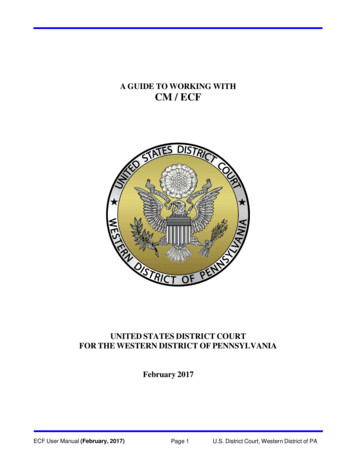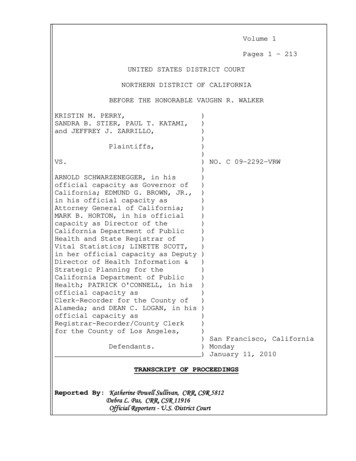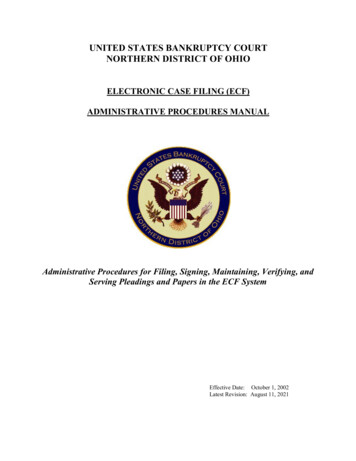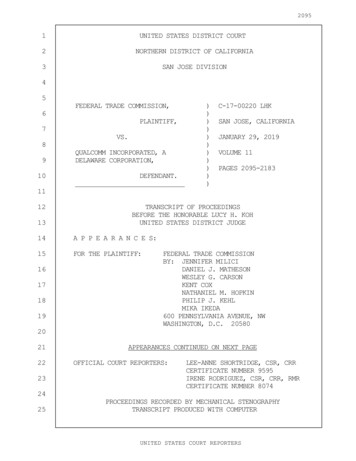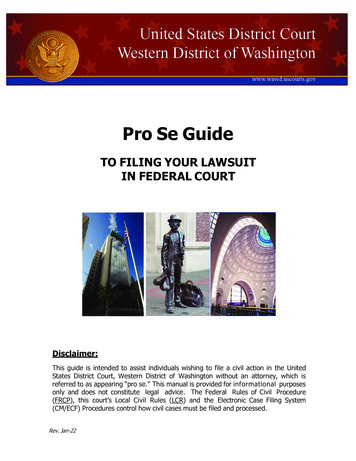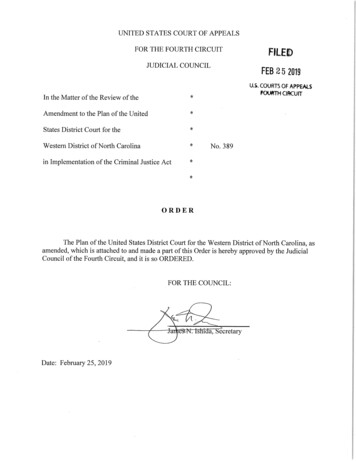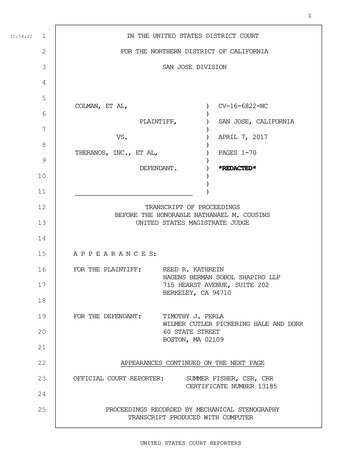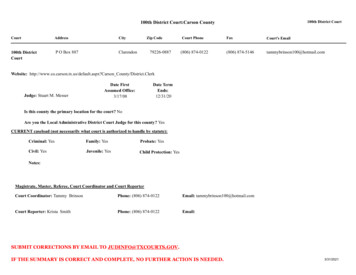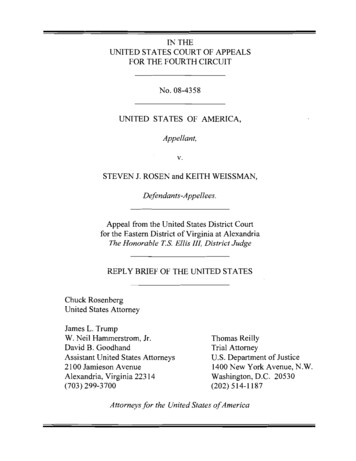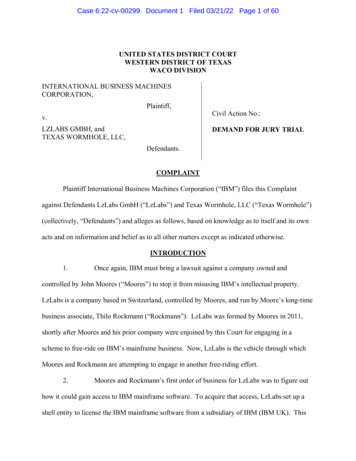
Transcription
Case 6:22-cv-00299 Document 1 Filed 03/21/22 Page 1 of 60UNITED STATES DISTRICT COURTWESTERN DISTRICT OF TEXASWACO DIVISIONINTERNATIONAL BUSINESS MACHINESCORPORATION,Plaintiff,v.LZLABS GMBH, andTEXAS WORMHOLE, LLC,Civil Action No.:DEMAND FOR JURY TRIALDefendants.COMPLAINTPlaintiff International Business Machines Corporation (“IBM”) files this Complaintagainst Defendants LzLabs GmbH (“LzLabs”) and Texas Wormhole, LLC (“Texas Wormhole”)(collectively, “Defendants”) and alleges as follows, based on knowledge as to itself and its ownacts and on information and belief as to all other matters except as indicated otherwise.INTRODUCTION1.Once again, IBM must bring a lawsuit against a company owned andcontrolled by John Moores (“Moores”) to stop it from misusing IBM’s intellectual property.LzLabs is a company based in Switzerland, controlled by Moores, and run by Moore’s long-timebusiness associate, Thilo Rockmann (“Rockmann”). LzLabs was formed by Moores in 2011,shortly after Moores and his prior company were enjoined by this Court for engaging in ascheme to free-ride on IBM’s mainframe business. Now, LzLabs is the vehicle through whichMoores and Rockmann are attempting to engage in another free-riding effort.2.Moores and Rockmann’s first order of business for LzLabs was to figure outhow it could gain access to IBM mainframe software. To acquire that access, LzLabs set up ashell entity to license the IBM mainframe software from a subsidiary of IBM (IBM UK). This
Case 6:22-cv-00299 Document 1 Filed 03/21/22 Page 2 of 60shell entity is called Winsopia. Winsopia has no business, except to act at the direction ofLzLabs. And that direction is to engage in improper reverse engineering of the IBM software togain IBM’s trade secret and proprietary information. LzLabs then uses this information todevelop a product offering that LzLabs claims is a plug-and-play replacement for the very IBMofferings LzLabs deceitfully obtained – IBM’s industry-leading mainframe system software.3.LzLabs’ alleged plug-and-play replacement for IBM’s mainframe systemsoftware is called the Software Defined Mainframe (“SDM”). LzLabs claims its SDM can runcustomer owned software applications written for IBM mainframes and process the related datawithout making modifications to the code or data for those applications, thereby, (according toLzLabs), duplicating the functionality of IBM mainframe systems.1 While IBM has committeddecades of engineering effort and billions of dollars of investment to develop its industry-leadingmainframe systems, LzLabs claims to have achieved this feat in a fraction of the time and with afraction of the engineers IBM used.4.After IBM UK learned of the connection between the shell entity Winsopiaand LzLabs (and to ensure compliance with the agreements by which the shell entity licensed themainframe software), IBM UK exercised its audit rights under its agreements with Winsopia.Winsopia, however, refused to comply with the audit request, even though IBM UK’s auditrights under the agreements are not discretionary and do not require assent. In fact, before itwould even entertain the audit request, Winsopia demanded that IBM UK sign a non-disclosureagreement that effectively required IBM to waive its legal rights before Winsopia provided anyof the requested information.1Even if the SDM could run IBM mainframe applications without modification, which it likely cannot, the SDMcannot provide the same reliability, security, availability and performance as the IBM mainframe systems.2
Case 6:22-cv-00299 Document 1 Filed 03/21/22 Page 3 of 605.Despite the efforts LzLabs has taken to conceal its wrongful activity, IBM hasrecently collected what information it can find, and as detailed below, has determined what logicdictates, i.e., that LzLabs could not have developed its SDM offering with the specificfunctionality it claims without misappropriating IBM’s intellectual property.6.Remarkably, as mentioned above, this is not the first time Moores andRockmann have attempted to free-ride on IBM’s mainframe business and cover it up. The firstattempt by the pair to misappropriate IBM’s intellectual property was through a company calledNeon Enterprise Software, LLC (“Neon”). Moores controlled Neon, and Rockmann ran Neon’sEuropean sales efforts.7.In 2009, Neon introduced a product named “zPrime.” zPrime modified theoperation of IBM’s mainframe systems to enable customers to offload processing from certainIBM mainframe processors and, in turn, to reduce the fees customers owed to IBM for IBMsoftware. The modifications were a direct violation of the customers’ contracts with IBM, andNeon knew it. In fact, at the time, Rockmann admitted that zPrime went “against what IBMintended their systems to do.”2 Nonetheless, Neon proceeded with its efforts, believing it couldgenerate a revenue stream based on a percentage of the fees its software allowed customers tosave – even though the generation of that revenue stream was illegal, because it depended oninducing IBM’s customers to breach their agreements with IBM by misappropriating computingcapacity.8.Neon’s scheme also depended on its misuse of IBM’s intellectual property.Unable to develop the zPrime software legally, Neon, having acquired an IBM mainframe2Peter Judge, IBM Tries To Stall Neon’s zPrime Mainframe Booster, Silicon.co.uk (Aug. 28, ame-booster-1708(last visited February 17, 2022).3
Case 6:22-cv-00299 Document 1 Filed 03/21/22 Page 4 of 60system (including the operating system software), illegally reverse-engineered IBM software todiscover and use IBM proprietary information, made illegal copies of IBM software, and causedusers of its zPrime software to do so as well – all in violation of IBM’s intellectual propertyrights and the agreements under which Neon licensed the IBM mainframe software.9.In 2010, IBM brought claims against Neon for tortious interference withIBM’s contracts with its customers, breach of Neon’s own license to IBM’s mainframe software,copyright infringement, and Lanham Act violations. See Neon Enterprise Software, LLC v.International Business Machines Corp., Case No. 1:09-cv-00896 (W.D. Tex.). Then in 2011,this Court entered a permanent injunction against Neon, Moores, and a number of Neonexecutives. Neon Enterprise Software, LLC v. International Business Machines Corp., Case No.1:09-cv-00896 (W.D. Tex.), Dkt. 165 (May 31, 2011). The permanent injunction resulted notonly from Neon’s misuse of IBM’s intellectual property rights and breach of Neon’s contractualobligations to IBM, but also from Neon’s blatant attempt to hide its wrongdoing by destroyingevidence and misrepresenting its conduct—under oath—even after the litigation was filed.10.Not to be deterred, even after this Court stopped them once, Moores andRockmann have picked up where they left off, with LzLabs as the “new Neon.” While LzLab’sendgame is the same as Neon’s—to free ride on IBM’s mainframe business—it is doing so in adifferent way. Rather than divert a portion of the revenue owed by customers for their use ofIBM mainframe computing resources, LzLabs engaged in a scheme to replace the entire IBMmainframe system. LzLabs could have competed legally for these computing workloads, but itdid not even attempt to do that. But like Neon before it, LzLabs chose a path that violated IBM’srights. LzLabs’ efforts should end the same way Neon’s efforts ended – with this Court ordering4
Case 6:22-cv-00299 Document 1 Filed 03/21/22 Page 5 of 60LzLabs to stop its wrongful conduct and properly compensate IBM for the misuse of itsintellectual property.JURISDICTION AND VENUE11.The Court has jurisdiction over this action under 28 U.S.C. §§ 1331, 1338,and 1367.12.Personal jurisdiction is proper against LzLabs because it has engaged insubstantial activities in the United States in connection with the development, marketing, andoffers for sale of its SDM. LzLabs engages in widespread marketing efforts of its SDM in theUnited States.3 LzLabs also advertises several major partnerships providing access to its SDMthrough the cloud.4 Moreover, LzLabs has made direct offers for sale and engaged in numerousdiscussions concerning the operation of the SDM with at least one IBM mainframe customer inthe United States.13.LzLabs has engaged in development work for its SDM in the United States,including within Texas. Defendant Texas Wormhole is LzLabs’ Austin, Texas-baseddevelopment arm, engaging in development of the SDM in this District. Texas Wormhole actsunder the direction (and for the exclusive benefit) of LzLabs. By way of example, TexasWormhole employees Steve Towns5, Gary Trinklein6, Tom Harper7, and Tommy Sprinkle83See, e.g., ions/ (last visited February 17, 2022).4See, e.g., ions/ (last visited February 17, 908218/) (last visited February 17, b5480942/) (last visited February 17, 7216/) (last visited February 17, 50a63599/) (last visited February 17, 2022)5
Case 6:22-cv-00299 Document 1 Filed 03/21/22 Page 6 of 60reside, according to their respective LinkedIn profiles, in Texas, and all have roles relating tosoftware development, such as software engineer, developer, or architect. Tom Harper isexpressly named in the Neon injunction. These individuals’ work for LzLabs includesdevelopment of the LzLabs SDM including the reverse assembling, reverse compiling,translating, or reverse engineering of IBM software to develop the SDM.14.Venue is proper in this District under 28 U.S.C. § 1391 and 1400. Forexample, Texas Wormhole has a regular and established place of business in this District andengages in development and use of the SDM in this District, actions that infringe the patentsasserted in this action. LzLabs has directed Texas Wormhole’s misappropriation in this District.Furthermore, because LzLabs is a foreign corporation subject to personal jurisdiction in theUnited States, venue is proper in any United States District Court for the causes of actionasserted here.THE PARTIES15.Plaintiff IBM is a corporation organized and existing under the laws of NewYork, with its principal place of business in Armonk, NY. IBM designs, manufactures, sells, andlicenses computer hardware and software, and provides related services.16.Defendant LzLabs is a company organized and existing under the laws ofSwitzerland with its principal place of business at Richtiarkade 16, 8304 Wallisellen,Switzerland. LzLabs purports to be a software development company.17.Defendant Texas Wormhole, LLC is an LLC organized and existing under thelaws of Delaware, with its principal place of business at 111 Congress Avenue, Suite 2600,Austin, TX 78701. It is an affiliate of LzLabs and works on the development of LzLabs’ SDM atthe direction of, and for the benefit of, LzLabs.6
Case 6:22-cv-00299 Document 1 Filed 03/21/22 Page 7 of 60FACTSIBM Mainframes18.As part of its server and hybrid cloud offerings, IBM designs, manufactures,and sells IBM mainframe systems that are extremely reliable and secure and that experienceminimal downtime and that are used by IBM’s customers, including large companies,governments, and organizations for a variety of critical computing work. These systems includehardware, such as the mainframe servers and storage devices, as well as operating systems andother software designed, developed and licensed by IBM. IBM mainframe systems can storemassive amounts of data and process billions of calculations and transactions in real time. Theyare critical to commercial databases, transaction servers, and other applications that require highresiliency, security, and agility. IBM customers use their mainframe systems for a wide range oftasks such as processing customer orders, executing secure and voluminous financialtransactions, managing payrolls, and tracking inventory. IBM’s current line of mainframecomputers consists of its IBM Z models, the most recent being the IBM z15.19.IBM’s mainframe computer servers face intense competition from many on-premises and cloud server offerings, including Linux and Microsoft Windows-based systemsexecuting on x86-based computer architectures, with respect both to retaining existingcomputing workloads and attracting new workloads. IBM mainframe systems represent a smallportion of all servers, whether on-premises or cloud based. IBM has continued to invest in its Zmainframe computer servers and software to provide customers a computing platform with thehighest security, performance, and availability. For example, IBM’s continued investment hasresulted in important innovations in areas such as cybersecurity, encryption and artificialintelligence.7
Case 6:22-cv-00299 Document 1 Filed 03/21/22 Page 8 of 6020.IBM welcomes competition, believing that competition drives innovation andresults in improved performance, value, and reliability for its customers. However, thatcompetition must be lawful. IBM brings this suit to address LzLabs’ unlawful development ofits SDM and illegal use of IBM’s software.The Proprietary IBM Multi-Level Software Environment21.As described more fully below, IBM has created a multi-level softwareenvironment, based on a proprietary mainframe Instruction Set Architecture, to operate on itsmainframe computers. IBM developed the collection of software that forms this multi-levelsoftware environment through extensive software engineering and research and developmentefforts over a period of approximately 60 years and an investment of billions of dollars. Theextensive effort and investment have resulted in a secure and proprietary multi-level softwareenvironment that is protected by valuable intellectual property rights of IBM.22.Figure 1, below, shows the levels of the IBM mainframe software andhardware environment. The top four levels represent software, and the fifth and lowest levelrepresents the mainframe computer hardware (which is a combination of hardware andspecialized software). The top level of the diagram shows customer applications, which areprograms that are generally developed for the specific needs and business of a customer. Thenext level down shows the compilers and run time services that are used to turn the languageused to write the customer application (often referred to as source code) into code that can be runon the hardware itself, together with run time services. The third level down shows themiddleware services that provide necessary functions (such as database and customer transactionprocessing functions) necessary to support the customer application. The fourth level downshows the operating system layer, which provides additional services and access to the8
Case 6:22-cv-00299 Document 1 Filed 03/21/22 Page 9 of 60underlying hardware functions. And the bottom level shows the processing of the instructionsthat are run on the processors of the hardware itself.Fig. 1: IBM Mainframe Environment23.The software programs or “applications” shown in the top layer can be writtenby IBM, independent software vendors, or IBM customers to perform user-oriented tasks.Application software programs perform specific functions for users, such as processing financialtransactions or payroll management. These are typically programs with which the customerinteracts and that provide functionality developed or tailored specifically for a complex businessneed of the customer – such as secure banking transactions, shipping logistics, or a worldwideairlines reservation system. Most mainframe applications need to be constantly on-line (meaningvery little downtime), secure, fast, and capable of processing large amounts of data.24.Customer applications for use on the IBM mainframe (such as those describedabove) are typically written in high-level (somewhat English-like) programming languages, suchas COBOL (COmmon Business Oriented Language) or PL/I (Programming Language One). A9
Case 6:22-cv-00299 Document 1 Filed 03/21/22 Page 10 of 60program as written by a programmer (in COBOL, PL/I, or another programming language) isgenerally referred to as the “source code” for the program.25.The next level, i.e., the second layer in Figure 1, includes “compilers” and“run-time services.” Programs called “compilers” translate source code that is written in alanguage such as COBOL or PL/I into “machine language” instructions that the computerultimately processes. Like any computer, an IBM mainframe computer contains varioushardware components, including processors (which perform computations and executeinstructions) and memory (which stores data used by the computer). These components onlyunderstand data and instructions in binary form (i.e., in “1”s and “0”s). Moreover, the processorsonly understand and process a particular set of instructions, and accordingly, every program thata computer processor executes must be comprised of instructions in the language that computerprocessor is programmed to run. These instructions are commonly referred to as “machinelanguage.” The machine language produced by a compiler (such as the COBOL compiler shownin Figure 1) is typically referred to as the “object code” for the program. After compilation, theresulting object code is organized9 into what is called an executable load module that interactswith the compiler run-time services and with the middleware layer, the operating system layer,and the processors that execute the machine instructions, each of which is described below. Theexecutable load module may be repeatedly executed without re-compiling the source code.26.Compilers generally translate source code instructions written by theprogrammer directly into sets of machine language instructions. However, for certain sourcecode instructions—typically those that require complex sets of machine language instructions—9This process involves binding (or “link-editing”) the object code for customer-written programs together with theobject code for various IBM-written licensed programs.10
Case 6:22-cv-00299 Document 1 Filed 03/21/22 Page 11 of 60compilers embed in the object code sets of machine language instructions that result in “calls” tocertain pre-coded auxiliary service routines. IBM’s COBOL and PL/I compilers use thistechnique, and such service routines are generally referred to as IBM’s “COBOL & PL/IRuntime Service Routines.” Each COBOL & PL/I Runtime Service Routine is a program or setof programs that includes valuable code created by IBM software engineers. COBOL & PL/IRuntime Service Routines are included in a software library that is provided to customers undera license that restricts what can be done with them. Unlike the Middleware Service Routinesdescribed below, the requests for which are generally coded by the customer applicationprogrammer, calls to COBOL & PL/I Runtime Service routines are typically inserted by thecompilers and operate within the customer application program without the need for thecustomer application programmer to be aware of or actively involved with the process ofembedding the requests for, or “calls” to, these service routines. Determining all the non-publicdetailed information regarding the COBOL & PL/I Runtime Service Routine code can only beaccomplished through substantial effort that is prohibited by the license agreement coveringthese services.27.Middleware products form the next level down, i.e., the third level from thetop, in Figure 1. The listed IBM middleware products are specialized programs, the primarypurpose of which is to provide commonly used services to customer application programs, aswell as to assist in setting up the complex environments necessary for the operation of customerapplications. As indicated in the diagram, the IBM middleware programs that contain such“Middleware Service Routines” that IBM has developed for use with its IBM Z mainframemachines include IBM’s Customer Information Control System (“CICS”), its InformationManagement System (“IMS”), and its Db2 products, each of which is described below.11
Case 6:22-cv-00299 Document 1 Filed 03/21/22 Page 12 of 6028.CICS is a middleware service that provides a general-purpose transaction-processing subsystem that can be utilized by the customer applications to provide necessaryfunctionality to run an application online. For example, applications can be made accessible tousers from local or remote workstations, so that the application can process requests from oneuser while other users of that application can submit requests that utilize the same programs,files, and data at the same time the original request is being processed.29.IMS provides database services commonly used to process onlinetransactions, as well as transaction processing services like those provided by CICS. Thedatabase services provided by IMS involve databases in which the data is organizedhierarchically. Those provided by Db2 involve “relational” databases, in which the data isorganized in sets of related tables.30.These middleware products provide customer applications with the ability tocall a large variety of IBM software modules to provide functionality commonly needed toimplement the types of customer applications generally run by IBM mainframes, without theneed for the customer application developer to write all the complex code necessary toimplement such functionality.31.Like COBOL and PL/I Runtime Service Routines, each IBM MiddlewareService Routine is a valuable program or set of programs that represents the fruits of extensivecoding and research and development efforts by IBM software engineers over the course ofmany years. Each such Middleware Service Routine serves as a software module that can beinvoked by a customer application, which—among other benefits—saves customer applicationdevelopers from having to write the code that is contained in the module. When the customerapplication developer writes a customer application, she can include language that will, after12
Case 6:22-cv-00299 Document 1 Filed 03/21/22 Page 13 of 60translation and compilation, result in binary code that sets up the input for, calls, and receives theoutput from a given Middleware Service Routine providing the commonly desired functionality.32.IBM provides its Middleware Service Routines to customers for a fee andpursuant to a license that restricts what can be done with them. Customers who pay for a licenseto middleware containing such Middleware Service Routines are provided with high-leveldescriptions of the operation of each Middleware Service Routine and an ApplicationProgramming Interface (“API”) specification of how to write, in a customer application program,source code that will result in binary code that invokes the desired service provided by themiddleware, but IBM ordinarily does not provide them with a detailed description of theMiddleware Service Routine code or architecture, or with all the detailed information about howthe Middleware Service Routine code interacts with compiled application code. Determining allthe non-public, detailed information regarding the Middleware Service Routine code can only beaccomplished through substantial effort that is prohibited by the license agreement coveringthese services.33.At the next level down in Figure 1, i.e., the fourth level from the top, theoperations of the IBM mainframe environment are coordinated by one or more operating systems(“OS”). OS programs provide additional callable services and manage a computer system’sinternal workings (often referred to as “hardware”), including the allocation, use, andmanagement of memory, processors, connection paths for input and output, devices, and filesystems. IBM’s primary proprietary operating system for its mainframe computers is called“z/OS,” which IBM first released in 2001. It is compatible with a range of commercial andopen-source application software programs and is designed to be backward compatible witholder systems and software. OS programs, such as z/OS, also provide an additional set of13
Case 6:22-cv-00299 Document 1 Filed 03/21/22 Page 14 of 60services (called Operating System Services) that can be used by customer application programs.Examples of such services are those provided by the VSAM (Virtual Storage Access Method)component of z/OS, which includes services to assist customer application programmers inperforming complex tasks such as reading and writing information to various external datastorage devices, such as tape drives, disk drives, and other, more complex mass storage facilitiesthat house the enormous amounts of data that are processed by today’s mainframe computersystems. As with the middleware services, customers who pay for a license to IBM’s z/OSoperating system containing such Operating System Services are provided with high-leveldescriptions of the operation of each available Operating System Service and an APIspecification explaining how to set up the input for, call, and receive the output from each suchservice in a customer application program. But IBM ordinarily does not provide customers witha detailed description of the Operating System Service’s code or architecture or all the ways itinteracts at a binary level with compiled application code. Once again, determining all the nonpublic detailed information regarding the Operating System Service code can only beaccomplished through substantial effort that is prohibited by the license agreement coveringthese Operating System Services.34.The bottom layer of the IBM mainframe environment, the lowest level inFigure 1, is the hardware itself.10 The IBM mainframe hardware is designed to provide acomplex and specific Instruction Set Architecture (“ISA”) executed on the processors, and likeother competing hardware platforms, it will only execute programs composed of machineinstructions that conform to that architecture. IBM’s proprietary mainframe ISA has been10The hardware includes embedded software referred to as Licensed Internal Code, millicode, or microcode.Together, this hardware and embedded software comprise the machine interface as seen by the upper softwarelayers.14
Case 6:22-cv-00299 Document 1 Filed 03/21/22 Page 15 of 60steadily extended and improved over approximately 60 years to the point where the ISA nowincludes about 1200 instructions, along with a complex, and similarly evolved, architectureinfrastructure that is necessary for these 1200 instructions to properly operate.35.As noted above, the IBM Compilers (along with their associated run timeservices), the IBM Middleware Service Routines, and the IBM Operating System Services areprovided to a customer only pursuant to a license agreement. Such license agreements allow thecustomer to utilize the software only in certain prescribed ways and for certain purposes. Theselicense agreements also prohibit certain activity with respect to the licensed software. Amongother things, the license agreements prohibit the reverse assembly, reverse compilation,translation and/or reverse engineering of the IBM software. This in turn protects the IBM tradesecrets embodied within such software that have resulted from decades of development and theinvestment of billions of dollars. Generally, the IBM software described above is provided to thecustomer only in object (or binary) form. It is a string of 1s and 0s that are not, in anymeaningful sense, readable by humans. However, reverse assembly, reverse compilation,translation, and/or reverse engineering of the IBM binary software could enable someone todiscern the proprietary structure, form, operation, and implementation details of the IBMsoftware, and use of this information would amount to an ill-gotten benefit of the investmentsIBM has made over many years to develop such software. Because this is a common issue withsoftware, software today is often provided to users only in object form and under licenseagreements containing similar prohibitions on reverse assembly, reverse compilation, translationand/or reverse engineering.36.Many of the various internal components of the IBM software and hardwarearchitecture are trade secrets, and IBM’s license provisions that prohibit the reverse assembling,15
Case 6:22-cv-00299 Document 1 Filed 03/21/22 Page 16 of 60reverse compiling, translating, or reverse engineering of IBM object code are a crucial elementof their protection. Although certain information about external aspects of the software andrelated architecture may be provided to customers, core information about internal aspects of thesoftware is typically not made available to customers and is not otherwise generally known to,nor ascertainable by authorized means by customers or other persons who can obtain economicvalue from their disclosure or use.37.IBM holds numerous patents resulting from the development of its mainframesystem. Many of these patents are related to its mainframe ISA, operating systems, middleware,and software applications, as well as patents relating specifically to computer programs foremulation and translation procedures that provide efficiency in the complex mainframeenvironment or non-mainframe environments where mainframe hardware or software emulationis performed.38.As explained below, in the development, sale, offer for sale, importation,installation, and operation of its “Software Defined Mainframe,” LzLabs misappropriatedvaluable IBM trade secrets and has infringed the five IBM patents discussed further below.16
Case 6:22-cv-00299 Document 1 Filed 03/21/22 Page 17 of 60LzLabs’ Software Defined Mainframe39.Defendant LzLabs claims it has developed wha
IBM's contracts with its customers, breach of Neon's own license to IBM's mainframe software, copyright infringement, and Lanham Act violations. See Neon Enterprise Software, LLC v. International Business Machines Corp., Case No. 1:09-cv-00896 (W.D. Tex.). Then in 2011, this Court entered a permanent injunction against Neon, Moores, and a .
